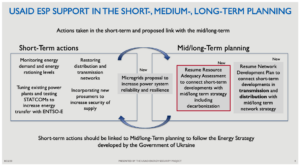On August 16th, the USAID Energy Security Project (ESP) launched a project called “Resource Adequacy Assessment of the Integrated Power System of Ukraine” (RAA Project) aimed at preparing scenarios and plans to renovate the electricity system and develop investment promoting mechanisms to address short, medium, and long-term needs in compliance with the methodology proposed by the Agency for the Cooperation of Energy Regulators (ACER).

At the online event, Fatih Kolmek, USAID ESP Senior Electricity Manager, said that RAA Project started before Russia’s full-scale invasion of Ukraine. “We had to pause this activity and focus on achieving and advancing the synchronization with ENTSO-E as well as restoring the damaged infrastructure to keep the lights on, but now, we renew it and aim to develop a plan to improve and renovate Ukraine’s electricity sector. The RAA Project has specific components to address the urgent needs due to the war while also focusing on the sector’s medium and long-term sustainable and reliable development. Hence, it is fair to say that the project is now more relevant than ever.” noted Fatih Kolmek.
Kathleen Kirsch, Energy Officer at USAID/Ukraine, emphasized that through its Energy Security Project, USAID has provided substantial assistance to restore the energy infrastructure and reintegrate these services for thousands of Ukrainians affected by Russia’s full-scale invasion of Ukraine. “The restoration of the electricity networks follows the Build-Back-Better initiatives. This serves as a strategic plan to strengthen Ukraine’s energy infrastructure, enhancing its resilience and playing a pivotal role in the investment landscape within the energy sector,” said Kathleen Kirsch.
Recognizing the necessity of linking short-term actions with medium and long-term energy goals, Vadym Virchenko, USAID ESP Deputy Chief of Party, said at the event that USAID ESP conducts various technical assistance projects in coordination with Ukrainian energy authorities. “These are designed to craft a comprehensive road map that encompasses the resource adequacy, power system flexibility, network development plan for transmission and distribution systems, and deployment of microgrids for critical loads,” Vadym Virchenko summarized.
Kostyantyn Uschapovskyi, the National Energy and Utilities Regulatory Commission Chairman, thanked USAID ESP for the support and close cooperation in implementing the energy market reforms. “For many years now, the USAID Energy Security Project has been helping Ukraine improve the regulatory environment, thereby strengthening the energy sector and Ukraine’s energy security. Today’s meeting is no exception because the RAA Project is an important tool that allows us to assess the capabilities of existing generating capacities and model the power system’s future development, considering economic and energy development scenarios,” noted Kostyantyn Uschapovskyi.
Oleksandr Martyniuk from the Directorate of the Electricity Complex and Development of the Electricity Market of the Ministry of Energy also thanked USAID ESP for raising essential and science-intensive topics for the industry and mentioned the following Ministry’s proposal. “The whole sector and the Ministry are focusing on developing decentralized generation in the future and, of course, restoring the damaged energy infrastructure. For this distributed decentralized generation to develop, economic incentives are needed. We have already provided one of the options in the Law of Ukraine 3220-IX On Amendments to Certain Laws of Ukraine regarding the restoration and “green” transformation of the energy system of Ukraine, where consumers will have the opportunity to install generating plants and use the generated energy for their consumption. Perhaps other mechanisms of such support should be reflected in the study for future reference.” added Oleksandr Martyniuk.

Following the opening session, Victor Bedoya Restrepo, USAID ESP Energy Sector Specialist, presented an overview of the development and reconstruction of Ukraine’s power system, focusing on supporting different energy authorities in Ukraine. The USAID ESP assistance is directed at enhancing the reliability and resilience of the power system with a focus on keeping the lights on in Ukraine.
Dmitri Perekhodtsev, Vice President of the COMPASS LEXECON, the partner organization in the RAA Project, presented the purpose and structure of the study assessing the adequacy of the Integrated Power System of Ukraine (IPS) and developing guidance on the short-and medium-term reconstruction and long-term development of the IPS of Ukraine in line with the Energy Strategy 2050. The study will also include recommendations for appropriate investment mechanisms and capacity remuneration mechanisms for achieving the objectives at different time frames.
Through the RAA Project, USAID ESP and COMPASS LEXECON experts will deliver several tasks, namely:
- Calculation of the Value of Lost Load (VoLL), the Cost of New Entry (CONE), and the Reliability Standard (RS) for the IPS of Ukraine.
- Guidance on the short-term recovery, e.g., winter 2023/24 and 2024/25, and reconstruction of the Ukraine energy infrastructure for 10 years.
- A Resource Adequacy Assessment for the IPS of Ukraine s, including system flexibility assessment and needs.
- Recommendations for an investment mechanism for short-term capacity expansion and CRM to address resource adequacy issues and needs for the reconstruction and development of the IPS.
- An optimal resources capacity expansion analysis until midcentury in line with European decarbonization policies and the Energy Strategy 2050 recently adopted by the Ukrainian Government.
All deliverables are expected to be completed in spring 2024.
